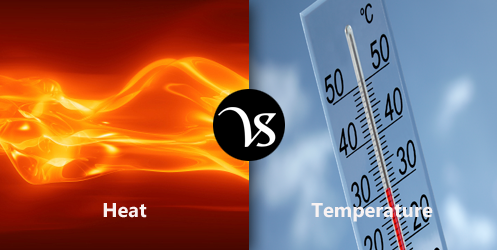 Heat:
Heat:
Heat is a transfer of energy other than by work or transfer of matter. Heat flows spontaneously from a hotter body to a colder one whenever a suitable physical pathway exists between bodies, and always results net in a net increase in entropy.
Temperature:
A temperature is a comparative objective measure of heat and cold. It is measured, by a thermometric material, detection of heat radiation, or by particle velocity or kinetic energy. It may be calibrated in any various temperatures scales, Celsius, Fahrenheit, Kelvin, etc. measurements with a small thermometer.
Differences:
| Basis | Heat | Temperature |
|---|---|---|
| Definition (www.oxforddictionaries.com) |
The quality of being hot; high temperature. | The degree or intensity of heat present in a substance or object, especially as expressed according to a comparative scale and shown by a thermometer or perceived by touch. |
| Synonyms | Warmth, hot weather, fever, hotness, and torridity | Climate, condition, degrees, febricity and body heat |
| Antonyms | Cold, coolness, frigidity ,chill, fire, inflame | Cool, apathy, rawness, dryness, frigidity and reserve |
| History | The history of the heat traces its origins to the first hominids to make fire and to speculate on its operation ad meaning to modern day physicists who study the microscopic nature of heat. | Galen, a Greek scientist and physician, made the first attempt at measuring temperature in A.D. 170. |
| Word origin | It was originated from Old English hǣtu (noun), hǣtan (verb), of Germanic origin; related to Dutch hitte (noun) and German heizen (verb), also to hot. | It was originated from Late Middle English: from French température or Latin temperatura, from temperare ‘restrain’. |
| Symbol | The symbol is Q. | The symbol is T. |
| Unit | The unit is Joules. | The unit is Kelvin, Celsius and Fahrenheit. |
| SI unit | Its SI unit is Joules. | Its SI unit is Kelvin. |
| Pronunciation | Eng (UK): / hiːt/ Eng (US): / hēt/ |
Eng (UK): /ˈtɛmp(ə)rətʃə / Eng (US): /ˈtemp(ə)rəCHər / /ˈtemp(ə)rəˌCHo͝or/ |
| Related | Heat is a measure of how many atoms are there in a substance multiplied by how much energy each atom passes. | Temperature is related how fast the atoms within a substance are moving. The temperature of an object is like the water level – it determines the direction in which “heat” will flow. |
| Particles | Heat is a measure of how many atoms there are in a substance multiplied by how much energy each atom possesses. | Temperature is related to how fast the atoms within a substance are moving. The temperature of an object is like the water level- it determines the direction in which ‘heat’ will flow. |
| Ability to do work | Heat has the ability to do the work. | Temperature can only be used to measure the degree of heat. |
| Example in Sentence |
|
|





